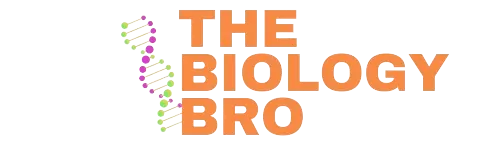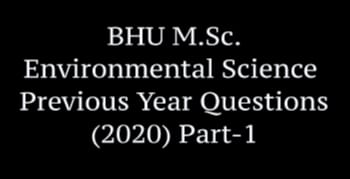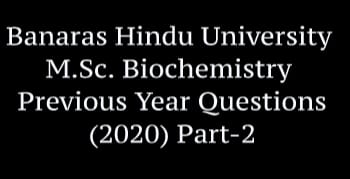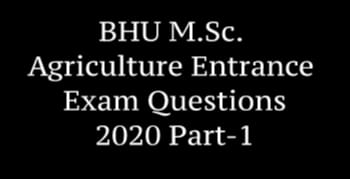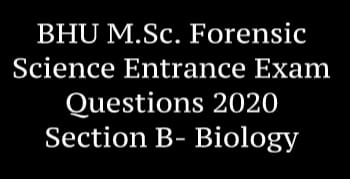Banaras Hindu University M.Sc. Environmental Science Solved Question Paper 2020
The M.Sc. environmental science entrance exam consists of 2 sections.
Section A- (Compulsory for all) 40 questions from Basic environmental science.
Section B- 80 questions for Life science or Zoology and Botany students
OR
Section B- 80 questions for Physical science
OR
Section B- 80 questions for Earth science students
Section A is provided below
Section A- Basic Environment Science
2020 Question Paper
-
Nickel is an essential for which enzyme in plants ?
- Fructose- 1,6- bisphosphatase
- Urease
- Catalase
- Sucrose synthase
-
Major reservoir of atmospheric OH molecule is :
- Hydroperoxyl radical
- Ozone
- Hydrogen peroxide
- Methane
-
How many goals are there in UN Sustainable Development Goals ?
- Seven
- Seventeen
- Fifteen
- Ten
-
Nutrient enrichment of water leads to :
- Solidification
- Nitrification
- Dentrification
- Eutrophication
-
Which of the following is the major source of atmospheric SO2 pollution ?
- Coal combustion
- Global warming
- Automobile emissions
- Biomass burning
-
Which among the following weeds in India having religion significance ?
- Eupatorium perfoliarum
- Panhenium hysterophorus
- Calorropis procera
- Ageratum conyzoides
-
Which of the following is a biodiversity hotspot in India ?
- Sunderbans
- Pachmarhi
- Rann of Kuch
- Western Ghats
-
UN agency for making policy guidelines regarding biodiversity conservation
and management is :- IUCN
- IPBES
- DIVERSITA
- IPCC
-
Blackfoot disease is caused by :
- Cadmium
- Mercury
- Arsenic
- Zinc
-
Largest source of freshwater resource on the Earth is
- Glaciers and permanent snow
- Groundwater
- Lakes and rivers
- Marshes and wetlands
-
Y- shaped energy flow model in the ecosystem was proposed by
- Lindeman
- Wiegert and Owen
- Odum
- Golley
-
Hot spots are the regions which are rich in
- Biodiversity
- Invasive species
- Nomadic population
- Atmospheric pollutants
-
The Environment (Protection) Act came into force in the year
- 1974
- 1980
- 1984
- 1986
-
Which of the following law states that the absorptivity and emissivity of a
substance are equal at each wavelength, λ ?- Stefan Boltzmann Law
- Stock’s Law
- Kirchhoff’s Law
- Henry Law
-
The capacity of an ecosystem to come back to its original state after a disturbance :
- Biotic potential
- Ecesis
- Carrying capacity
- Resilience
-
DDT is an example of :
- Carbonate
- Pyrethroids
- Organophosphate
- Organochloride
-
Which of the following is the cleanest city of India ?
- Ahmedabad
- Bhopal
- Shillong
- Indore
-
Large sized vessels for producing an industrial product at large scale is known as :
- Incubator
- Autoclave
- Bioreactors
- Centrifuge
-
Halocline is the region showing change in :
- Salinity
- Pressure
- Density
- Temperature
-
The agency responsible for monitoring SDGs implimentation in India :
- NGT
- MoEF & CC
- NITI Aayog
- DST
-
Kanha National Park is situated in :
- Assam
- Madhya Pradesh
- Uttar Pradesh
- Maharashtra
-
The flattest planet of the Solar System is :
- Pluto
- Jupiter
- Mars
- Saturn
-
‘Good economics for hard times’ written by :
- Y.N. Harari
- A. Banerjee & E.Duflo
- Jefferey D. Sachs
- Aldo Leopold
-
The measurement of appropriation of land and water area utilizable as a resource
as well as for the absorption of wastes is commonly referred to as :- Material footprint
- Water footprint
- Ecological footprint
- Energy footprint
-
The metal used to recover copper from a solution of copper sulphate is :
- Na
- Ag
- Hg
- Fe
-
Polar orbiting satellites are generally placed at an altitude of :
- 7-15 km
- 700- 1500 km
- 7000- 15000 km
- 70- 150 km
-
Which of the following is a major coal reserve in India ?
- Jaunpur
- Hissar
- Jharia
- Kottayam
-
Red data list includes those species that are :
- Harmful to human beings
- Responsible for pollution
- Facing the risk of extinction
- Abundant in nature
-
Which among the following is the classical book which
addressed the impact of DDT pollution is ?- The Sea Around Us
- The Sand Country Almanac
- Once Straw Revolution
- Silent Spring
-
Which of the following is mixed with Bitumen to lay roads ?
- Polychain
- Polybend
- Polynone
- Polyclean
-
Among of biodegradable oraganic matter in sewage water is estimated by measuring :
- Hardness
- Biochemical Oxygen Demand
- Chemical Oxygen Demand
- Alkalinity
-
Which of the following is an invasive species in India ?
- Water hyacinth
- Water lily
- Water chestnut
- Fox nut
-
Rad is a :
- Unit of radiation in environment
- Unit of radioactivity
- Unit of absorbed radiation dose
- Unit of radioactive breakdown of Radon
-
Which type of coal contain maximum sulphur ?
- Bituminous
- Anthracite
- Peat
- Lignite
-
In accordance of the ‘Paris Agreement’, India’s commitment to increase
the share of renewable energy by the year 2030 is :- 40% of installed capacity
- 40% of utilized capacity
- 45% of installed capacity
- 45% of utilized capacity
-
UN has recently declared 2021-2030 as :
- International decade of ecosystem restoration
- International decade of marine conservation
- International decade of forest restoration
- International decade of biodiversity conservation
-
Which of the following antibiotics block protein synthesis in bacteria ?
- Ampicillin
- Pencillin
- Carbenicilin
- Tetracycline
-
Rill, gully and riparian are types of :
- Wind erosion
- Water erosion
- None of the three
- Landslide erosion
-
In an ecosystem, the flow of energy is :
- Unidirectional
- Mutidirectional
- Cyclic
- Bidirectional
-
Most abundant element of earth crust is :
- Sulphur
- Aluminium
- Iron
- Oxygen

Time's up
